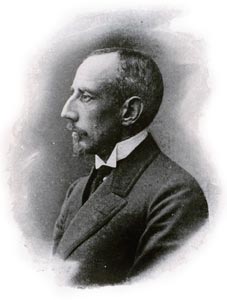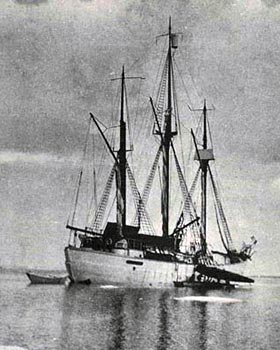 |
 |
| |
Frontispiece portrait
of Roald Amundsen, 1872-1928. In: "The South Pole", Volume
I. Archival Photograph by Mr. Steve Nicklas, NOS, NGS.
Image courtesy: NOAA
Photo Library. |
History
The Maud Expedition (1918-1925)
Having conquered the Northwest Passage
and the South Pole, Norwegian explorer Roald Amundsen set his
sights on the North Pole. He chose to adopt Fridtjof Nansen's
idea of freezing a ship into the ice and floating to the Pole.
However, the Fram was no longer seaworthy, so a new wooden vessel,
the Maud, was constructed with an egg-shaped bottom
to lift under ice pressure and avoid being crushed, similar
to the Fram. Despite the start of World War I, the Maud
departed Christiania (Oslo), Norway in July 1918, and set off
through the Northeast Passage, along the coast of Siberia, with
the intention of being frozen into the pack ice north of the
Bering Strait. However, the pack ice formed much earlier that
year, and by September the Maud and her ten passengers
were frozen in for the winter north of Cape Chelyuskin. The
crew included two of the four others who had reached the South
Pole with Amundsen, the chief engineer and sailmaker from the
Fram, and Harald Ulrik Sverdrup, a Norwegian oceanographer
who would later become director of the Scripps Institute of
Oceanography at La Jolla, California.
During the winter, Amundsen was without luck, as he broke his
arm, was mauled by a bear, and suffered from carbon monoxide
poisoning. Finally, in August the ice released its grip on the
Maud and the expedition continued eastward, leaving
two crew members behind who wished to return home. Though these
members were experienced in polar travel, they were never seen
again. Meanwhile, in September, the Maud was halted
by ice again, and frozen in for a second winter 500 miles short
of Bering Strait, near the mouth of the Kolyma River.
 |
 |
| The Maud at sea.
|
|
An encampment of Chukchi natives nearby provided intermittent
company for the expedition members during the second winter.
Little was known regarding the Chuckchis, so Amundsen, still
feeling too week from the carbon monoxide poisoning to go himself,
suggested to Sverdrup that he study the tribe. Sverdrup spent
the next seven and a half months learning the Chukchi language,
studying their customs, and even took a series of magnetic observations.
Meanwhile, Amundsen sent a small party on an overland journey
to send telegrams (and one troublesome crew member) to Norway,
covering 1000 miles to Anadyr and back in 6 months.
The following summer, Amundsen decided to sail to Nome, Alaska
to refit before continuing. They completed the Northeast Passage
and arrived there in July 1920. Here, three more members left
the expedition, leaving the Maud with only a crew of
four. Regardless, after ten days, Amundsen headed north again,
and became stopped in the ice in the Bering Strait, where the
Maud spent a third winter. By July 1921, Maud
was able to break out of the ice. However, damage to her propeller
forced her to head south instead of north to be overhauled in
Seattle, Washington. Amundsen went home to Norway, and returned
briefly the following summer, but left the expedition in order
to attempt to fly across the Arctic.
With Oscar Wisting in charge, the Maud headed north
again, but did not find the drift current across the Arctic
Ocean, and progressed no further north than the New Siberian
Islands, returning to Nome in August 1925.
References:
Amundsen, R., My Life as an Explorer, Doubleday, Doran
& Company, Garden City, New York, 292 pp., 1928.
Huntford, R., ed., The Amundsen Photographs, Atlantic
Monthly Press, New York, 199 pp., 1987.
On the web: Rine, L., The Life of Roald Amundsen
On the web: Roald Amundsen, Brief History
 Previous Chapter
Next Chapter
Previous Chapter
Next Chapter

|



